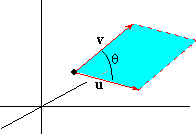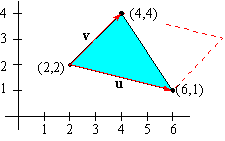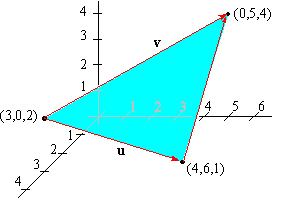Part 2: Area of a Parallelogram
In the last section, we saw that the 2 dimensional vectors u =
á u1,u2,0
ñ and v =
á v1,v2,0
ñ can be written in polar
form as
|
|
|
u =
á || u|| cos( a) ,|| u|| sin( a),0
ñ |
|
|
v =
á || v|| cos( b) ,|| v|| sin( b),0
ñ |
|
|
 |
|
Let's compute u×v in polar form using the formula (4):
|
|
|
| |
|
|
á 0,0,|| u|| cos( a)|| v|| sin( b) -|| v|| cos( b) || u|| sin(a)
ñ |
| |
|
|
á 0,0,|| u|| || v||[ sin( b) cos( a) -sin(a) cos( b) ]
ñ |
|
|
Simplifying with the difference of two angles formula for the sine function
yields
|
u×v =
á 0,0,|| u|| || v|| sin( b-a)
ñ |
|
However, the angle q between u and v is
related to b and a by q = | b-a| .
In fact, the following can be shown:
Theorem 3.3: If q is the angle formed by u and v, then
|
|| u×v|| = || u|| || v|| sin( q) |
 |
|
Moreover, since a parallelogram can be cut into two parts which
form a rectangle with height || v|| sin( q) and base || u|| ,

the area of the parallelogram formed by u and v is || u|| || v|| sin( q) . Thus, theorem 3.3 implies that

The latter result follows from the fact that u-v bisects the
parallelogram formed by u and v.
EXAMPLE 3 Find the area of the triangle with vertices at P1( 2,2) , P2( 4,4) , and P3(6,1) .

Solution: It is easy to see that u =
á2,2
ñ and v =
á 4,-1
ñ . As
vectors in R3, we have u =
á2,2,0
ñ and v =
á 4,-1,0
ñ .
Thus, their cross product is
Since the triangle has half of the area of the parallelogram formed by u and v, the area of the triangle is
|
Area = || u×v|| = |
|
 |
|
| 02+02+(-10) 2 |
|
= 5 units2 |
|
EXAMPLE 4 Find the area of the triangle with vertices P1( 3,0,2) , P2( 4,6,1) , and P3(0,5,4) .

Solution: To do so, we first construct the vectors u and
v:
|
 |
|
| u = |
P1P2 |
=
á4-3,6-0,1-2
ñ =
á 1,6,-1
ñ |
|
 |
|
| v = |
P1P3 |
=
á0-3,5-0,4-2
ñ =
á -3,5,2
ñ |
|
As vectors in R3, we now have u =
á2,2,0
ñ and v =
á 4,-1,0
ñ .
Thus, their cross product is
|
|
|
| |
|
|
á 6·2-5·( -1) ,( -1) ·( -3) -2·1,1·5-( -3) ·6
ñ |
| |
|
|
|
Since the triangle has half of the area of the parallelogram formed by u and v, the area of the triangle is
|
Area = || u×v|| = |
|
 |
|
| 172+22+232 |
|
= 14.335 units2 |
|
Check your Reading: What is the area of the parallelogram spanned by u
and v in example 4?










